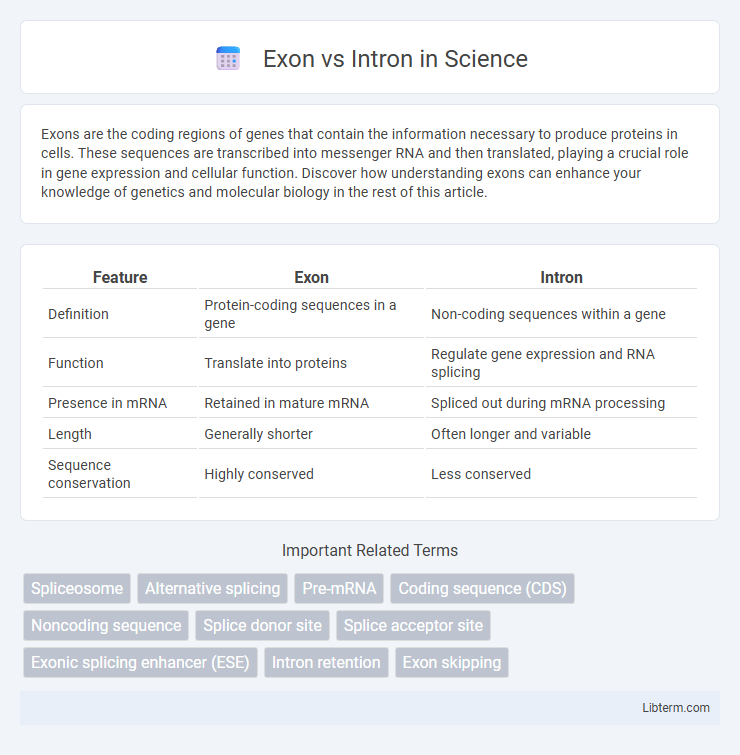Exons are the coding regions of genes that contain the information necessary to produce proteins in cells. These sequences are transcribed into messenger RNA and then translated, playing a crucial role in gene expression and cellular function. Discover how understanding exons can enhance your knowledge of genetics and molecular biology in the rest of this article.
Table of Comparison
| Feature | Exon | Intron |
|---|---|---|
| Definition | Protein-coding sequences in a gene | Non-coding sequences within a gene |
| Function | Translate into proteins | Regulate gene expression and RNA splicing |
| Presence in mRNA | Retained in mature mRNA | Spliced out during mRNA processing |
| Length | Generally shorter | Often longer and variable |
| Sequence conservation | Highly conserved | Less conserved |
Introduction to Exons and Introns
Exons are coding segments of a gene that contain the information required to produce proteins, while introns are non-coding sequences that are removed during RNA splicing. Exons are essential for translating genetic information into functional proteins, whereas introns regulate gene expression and facilitate alternative splicing. The interplay between exons and introns allows for genetic diversity and complexity in eukaryotic organisms.
Definition of Exons
Exons are segments of a DNA or RNA molecule containing information coding for protein synthesis. They are expressed sequences that remain in the mature messenger RNA (mRNA) after splicing removes introns, enabling translation into functional proteins. Exons play a crucial role in gene expression by determining the amino acid sequence of the encoded protein.
Definition of Introns
Introns are non-coding sequences within a gene that are transcribed into RNA but removed during RNA splicing to produce mature messenger RNA (mRNA). Unlike exons, which code for proteins, introns do not directly contribute to the amino acid sequence but play roles in gene regulation and alternative splicing. Their presence can influence gene expression patterns and increase protein diversity in eukaryotic organisms.
Structural Differences Between Exons and Introns
Exons are coding regions of a gene that are transcribed into mRNA and translated into proteins, characterized by shorter sequences with defined splice sites. Introns are non-coding segments situated between exons, typically longer and containing sequences that regulate gene expression and splicing. The primary structural difference lies in exon length and sequence conservation, whereas introns possess variable length with repetitive elements and less sequence conservation.
Biological Functions of Exons
Exons contain the coding sequences that are transcribed into mature mRNA and translated into functional proteins, playing a critical role in gene expression. They determine the amino acid sequence of proteins, influencing cellular structure, enzymatic activity, and regulatory functions. Exons also contribute to alternative splicing, allowing a single gene to produce multiple protein isoforms essential for biological diversity and adaptability.
Biological Roles of Introns
Introns play crucial roles in gene expression regulation by enhancing mRNA diversity through alternative splicing, allowing a single gene to produce multiple protein variants. They contribute to genome stability and evolution by facilitating recombination and harboring regulatory elements such as enhancers and silencers. Moreover, introns assist in mRNA export from the nucleus and influence gene expression timing and levels through their impact on transcriptional pausing and mRNA maturation processes.
Exon-Intron Organization in Eukaryotic Genes
Eukaryotic genes exhibit a characteristic exon-intron organization where exons represent coding sequences, while introns are non-coding segments interspersed within the gene. This modular architecture facilitates gene expression regulation through processes such as alternative splicing, which allows a single gene to produce multiple protein isoforms. The precise removal of introns and joining of exons by the spliceosome is essential for generating mature messenger RNA (mRNA) transcripts that translate into functional proteins.
Role in Gene Expression and mRNA Splicing
Exons encode the amino acid sequences essential for protein synthesis, directly influencing gene expression by determining the functional output of genes. Introns, non-coding segments, play a regulatory role by facilitating alternative splicing that increases proteomic diversity and controls mRNA maturation. The precise removal of introns and joining of exons during mRNA splicing ensures correct genetic information is transferred for translation, impacting gene expression efficiency and variability.
Evolutionary Significance of Exons and Introns
Exons and introns play distinct roles in genome evolution, with exons encoding functional protein sequences critical for organismal traits, while introns contribute to genetic diversity and regulatory complexity. The presence of introns allows for alternative splicing, generating multiple protein isoforms from a single gene, which increases evolutionary adaptability. Evolutionarily, exons are conserved due to their coding function, whereas introns evolve more rapidly, facilitating genome innovation and the emergence of new gene functions.
Medical and Biotechnological Implications
Exons encode the functional sequences of genes that translate into proteins, making them critical targets for gene therapy and precision medicine in treating genetic disorders. Introns, although non-coding, regulate gene expression and alternative splicing, influencing disease mechanisms and serving as important biomarkers in diagnostics and RNA-based therapeutics. Advances in CRISPR and RNA interference technologies exploit exon-intron structures to develop novel treatments for cancers, neurodegenerative diseases, and inherited conditions.
Exon Infographic

 libterm.com
libterm.com